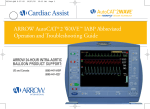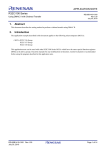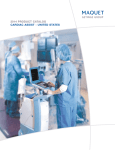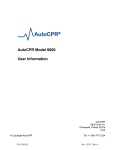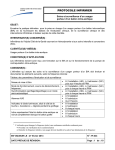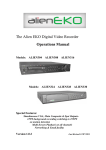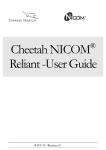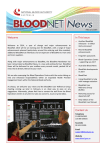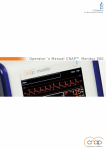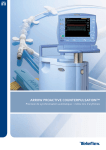Download Emergency Transfer Of Patients With An Intra Aortic Balloon Pump
Transcript
Document Type: Unique Identifier: PROCEDURE CORP/PROC/497 Title: Version Number: Emergency Transfer Of Patients With An Intra Aortic Balloon Pump ( IABP) From A District General Hospital To The Tertiary Centre Within The Lancashire And South Cumbria Cardiac Network. 2 Status: Ratified Scope: Classification: Cardiac Network-wide Organisational Author/Originator and Title: Responsibility: Lancashire and South Cumbria Cardiac Network and East Lancashire Hospitals NHS Trust Cardiac Network Replaces: Description of amendments: Version 1 Emergency Transfer Of Patients With An Intra Aortic Balloon Pump ( IABP) From A District General Hospital To The Tertiary Centre Within The Lancashire And South Cumbria Cardiac Network. CORP/PROC/497 Transfer of patient with iabp to tertiary centre Name of Committee: Divisional/Directorate/ Working Group: Date of Meeting: Risk Assessment: Not Applicable Financial Implications Not Applicable Validated by: Validation Date: Sally Chisholm, Cardiac Network Programme Director November 2008 Ratified by: Ratified Date: Date of Issue: Clinical Improvement Committee 03/11/2008 03/11/2008 Review Date: Review Dates: 2005 2006 2007 2008 2009 2010 01/11/2010 2011 2012 2013 2014 Review dates may alter if any significant changes are made Does this document meet with the Race Relation Amendment Act (2000) Religious Discrimination Act, Age Discrimination Act, Disability Discrimination Act and Gender Equality Regulations? Not Applicable 1 PURPOSE. To provide skilled personnel, the equipment necessary, and ensure the procedures are in place to allow the safe transfer of a patient with intra-aortic balloon pump from a district general hospital to the tertiary centre. 2 SCOPE. Network-wide across Lancashire and South Cumbria. To be implemented by the Cardiac Network and followed by medical staff at referring / treatment centre, and the ambulance Trust. 3 PROCEDURE 3.1 CRITERIA FOR USE OF THE INTRA AORTIC BALLOON PUMP (IABP) IABP may only be used in the following areas with the treatment initiated by Consultant Cardiologist: • Cardiac catheter lab • Coronary Care Unit • Critical Care Indications for use • Acute Myocardial infarction – cardiogenic shock • Refractory unstable angina • Ischaemic related intractable ventricular arrhythmias • Catheter lab complications • Prior to urgent cardiac surgery • Complications of acute myocardial infarction-ie ventricular septal defect/ papillary muscle rupture CONTRAINDICATIONS FOR USE OF IABP • Severe aortic valve insufficiency • Abdominal or aortic aneurysm • Severe calcific aorta iliac disease or peripheral vascular disease • Sheathless insertion with severe obesity, scarring of the groin INSERTION OF IABP • Once the Cardiologist has made the decision to insert an IABP and is going to transfer the patient to the Tertiary centre, staff at the referring hospital should follow the balloon pump transfer flow chart (Appendix 1). • If the anaesthetic team are involved with the patient, ensure the ICU transfer protocol is followed CORP/PROC/033 (see associated document). Ambulance control should be pre-warned that a transfer request is imminent so they can organise one of the six vehicles with the correct fittings to secure the balloon pump. Blackpool Fylde and Wyre Hospitals NHS foundation Trust Revision No: 2 I.D. No: CORP/PROC/497 Title: Emergency Transfer Of Patients With An Intra Aortic Balloon Pump ( IABP) From A District General Hospital To The Tertiary Centre Within The Lancashire And South Cumbria Cardiac Network. Do you have the up to date version? See the intranet for the latest version Page 2 of 10 Review Date:01/11/2010 • The Cardiologist should contact the tertiary centre to arrange transfer and the nurse should ring the perfusionist on 01253 657777 to inform of transfer. • If the patient requires an intensive care bed it is the responsibility of the accepting Consultant Cardiologist at the Tertiary centre to organise this. TRANSFER OF PATIENT WITH IABP TO TERTIARY CENTRE . Helimed is not to be used for transfer of patients with IABP in situ. When possible inform the patient and relatives of the reason for transfer and all other information related to the receiving area. Follow care plan post insertion of balloon pump (Appendix 2). Follow IABP transfer guidelines (Appendix 3) Occasionally patients may need to be transferred from the tertiary centre to another hospital outside Lancashire and South Cumbria. Clinicians must ensure that they liaise with the receiving hospital for procedure on arrival Check with crew on arrival which type of vehicle, either Ford or Mercedes so that staff can take correct restraint straps for that vehicle on the transfer. STAFF TRAINING FOR TRANSFER OF PATIENTS WITH IABP • All healthcare professionals should have completed the Datascope training and be working towards Datascope competencies (associated document) before transferring patients with IABP in situ. 4 ATTACHMENTS. Appendix 1 – IABP Transfer Policy Flowchart Appendix 2 – IABP Care Plan Appendix 3 – Guidelines for preparation and transfer of a patient with IABP to the Tertiary Centre Appendix 4 – IABP Observation Chart Appendix 5 – IABP Potential Alarms 5 ELECTRONIC AND MANUAL RECORDING OF INFORMATION. Database for Policies, Procedures, Protocols and Guidelines Archive/Policy Co-ordinators office Blackpool Fylde & Wyre Hospitals NHS Trust Archived at the Cardiac Network Office. Room 244, Preston Business Centre, Watling Street Road, Fulwood, Preston, PR2 8DY or via the Cardiac Network website – www.lsccardiacnetwork.nhs.uk 6 LOCATIONS THIS DOCUMENT ISSUED TO. Copy No Location Date Issued 1 Intranet Cardiac Network Wards and Departments 03/11/2008 03/11/2008 03/11/2008 Blackpool Fylde and Wyre Hospitals NHS foundation Trust Revision No: 2 I.D. No: CORP/PROC/497 Title: Emergency Transfer Of Patients With An Intra Aortic Balloon Pump ( IABP) From A District General Hospital To The Tertiary Centre Within The Lancashire And South Cumbria Cardiac Network. Do you have the up to date version? See the intranet for the latest version Page 3 of 10 Review Date:01/11/2010 7 OTHER RELEVANT/ASSOCIATED DOCUMENTS. Procedure No. CORP/PROC/033 8 Title Lancashire & South Cumbria Critical Care Network Guidance for Intra and Inter-Hospital Transfers. Datascope IABP Counterpulsation Competency Programme East Lancashire Hospitals NHS Trust Balloon Pump documents. Datascope Preparing the IABP for transport pictures Emergency Transfer Of Patients From A Peripheral Catheter Laboratory to Lancashire Cardiac Centre. AUTHOR//DIVISIONAL/DIRECTORATE MANAGER APPROVAL. Issued By P Black Job Title Service Manager Checked By Improvement Job Title Signature Date Signature November 2007 Blackpool Fylde and Wyre Hospitals NHS foundation Trust Revision No: 2 S Chisholm Date November 2007 I.D. No: CORP/PROC/497 Title: Emergency Transfer Of Patients With An Intra Aortic Balloon Pump ( IABP) From A District General Hospital To The Tertiary Centre Within The Lancashire And South Cumbria Cardiac Network. Do you have the up to date version? See the intranet for the latest version Page 4 of 10 Review Date:01/11/2010 APPENDIX 1 TRANSFER POLICY INTRA AOTIC BALLOON PUMP IABP in situ & emergency transfer required On arrival at Tertiary Centre hand over and swap over IABP and leads. Staff in charge of supporting patient Anaesthetic Team in charge of supporting TRANSFER TEAM Patient management in the ambulance: Physician (Cardiology registrar/ anaesthetist) Drug bag + airways Monitoring, HR, BP, Sao2, RR Constant monitoring of balloon pump (see care plan – Appendix 2) Care of infusions Healthcare professional (appropriately trained with use of the IABPdependent on infusion pumps) Consultant to contact Tertiary Centre to arrange transfer and advise location on Nurse to contact perfusionist, LCC (01253 657777) or accepting centre via switchboard • Inform of ETA • Organise replacement pump • Condition of patient • Size of catheter • Problems during insertion/ Await ambulance arrival Prepare equipment: IABP Harness Drug bag with airways (Appendix 3) • • Leave IABP plugged in until transfer (battery will last 2 - 2.5hrs) • • Constant monitoring and care of the balloon pump (Appendix 2) Continuous observations (Appendix 4) Contact relatives re transfer • • Blackpool Fylde and Wyre Hospitals NHS foundation Trust Revision No: 2 To book ambulance Ring 999 Confirm telephone number State ‘balloon pump transfer from …. To ….’ State what time patient expected to be ready for transfer Ask for incident number and whether paramedic on vehicle Any delay/change to transfer – ring 999 and state incident number/change to transfer I.D. No: CORP/PROC/497 Title: Emergency Transfer Of Patients With An Intra Aortic Balloon Pump ( IABP) From A District General Hospital To The Tertiary Centre Within The Lancashire And South Cumbria Cardiac Network. Do you have the up to date version? See the intranet for the latest version Page 5 of 10 Review Date:01/11/2010 Appendix 2 Intra-Aortic Balloon Pump Care Plan Post Procedure Instructions Following Insertion of the Intra- Aortic Balloon Pump Patients Name and Hospital Number. 1. 2. 3. 4. 5. 6. 7. 8. 9. 10. 11. 12. 13. 14. 15. 16. 17. 18. 19. 20. 21. 22. 23. 24. 25. 26. 27. 28. Ensure observations are completed on IABP observation chart, every 15 – 30 mins until stable, and then every hour. Has the position of the balloon been checked following insertion, either by x-ray or fluoroscopy? Check the augmented BP alarm is set at 10mmHg below augmented diastolic pressure. Is the tubing secure? The tubing should be visible at all times (both helium and arterial line tubing) Insertion site should be covered with a dry, sterile, adherent, transparent dressing. Zero and flush pressure lines at the beginning of each shift. Lines should be changed inline with Trust policy. Heparinised saline, 500iu/500ml should be used. (Tertiary centre policy). Put IABP on standby when flushing Anti-coagulant therapy is dependent on clinical condition and consultants choice.i.e LMWT heparin etc. Monitor coagulation and HB and other requested bloods daily. If patient ventilated follow Critical Care Unit protocols and guidelines. Assess patient for signs of pain or discomfort, give prescribed analgesia. Bed rest should be maintained. DO NOT raise head of bed > than 45°, but position the patient to maintain their comfort( lying on their side supported by pillows etc is fine) DO NOT flex or bend the leg in which the IAB is inserted. Dorsiflexion of foot on involved leg. Active and passive movements to uninvolved leg should be encouraged. Assist with washing and hygiene needs as required. Assist patient with leg rolling and positioning. Observe pressure areas and utilise equipment and follow Trust policy. Encourage deep breathing. Encourage fluids and diet as appropriate. Observe frequency of bowel movement and observe for signs of constipation and assist if necessary with elimination needs. Give simple explanations of IABP therapy and the patient information booklet to patient and family. Ensure family aware of future plans e.g. transfer. Give emotional support regarding fears and anxieties. Read policy and attached documents for a guide on helium cylinder change and harnessing for transfer, and transfer policy. For IABP alarms refer to troubleshooting guide and complication checklist and make use of the help screen. All other problems refer to Datascope manual and 24 hour help line. 01480 423600 Technical support, 0800 891201 Clinical support, or call the local representative direct. Ensure IABP daily maintenance checklist is completed. Remove balloon and introducer at the same time DO NOT remove balloon through Blackpool Fylde and Wyre Hospitals NHS foundation Trust Revision No: 2 I.D. No: CORP/PROC/497 Title: Emergency Transfer Of Patients With An Intra Aortic Balloon Pump ( IABP) From A District General Hospital To The Tertiary Centre Within The Lancashire And South Cumbria Cardiac Network. Do you have the up to date version? See the intranet for the latest version Page 6 of 10 Review Date:01/11/2010 introducer. Check coagulation status before removal. A Femostop II will be needed to apply pressure to the wound site, collect from Cath Lab, with instructions and care plan. REMOVAL SHOULD BE CARRIED OUT BY A HEALTHCARE PROFESSIONAL PROFICIENT IN FEMORAL SHEATH REMOVAL ( usually a Doctor ). 29. Follow infection control protocol on removal of invasive lines. Blackpool Fylde and Wyre Hospitals NHS foundation Trust Revision No: 2 I.D. No: CORP/PROC/497 Title: Emergency Transfer Of Patients With An Intra Aortic Balloon Pump ( IABP) From A District General Hospital To The Tertiary Centre Within The Lancashire And South Cumbria Cardiac Network. Do you have the up to date version? See the intranet for the latest version Page 7 of 10 Review Date:01/11/2010 APPENDIX 3 Lancashire & South Cumbria Cardiac Network GUIDELINES FOR PREPARATION AND TRANSFER OF A PATIENT WITH INTRA AORTIC BALLOON PUMP (IABP) TO THE TERTIARY CENTRE 1. At all times the medical staff will take the lead and have overall responsibility for the patient. 2. There is only room to accommodate two transfer staff in the ambulance other than the ambulance crew. 3. Rules for transfers DO NOT transfer the patient: If you are concerned about their ability to cope with the transfer process. Until their condition is deemed stable enough to transfer. Until all lines, drains, tubes, leads etc are appropriately secured. Until all transfer equipment has been checked for accuracy and reliability. Until appropriately skilled transfer personnel are available. Until the receiving area is prepared to receive the patient. 4. Ensure IABP is removed from its hospital cart and have the blue securing harness fitted before the ambulance arrives. Harnessing the IABP ( see Datascope step by step picture guide) Remove the drip stand Press down the catch under the handle on the hospital cart and swivel the monitor anticlockwise out of the way. Ensure the hospital cart brakes are on. Release the lever at the bottom of the IABP to disconnect the pump from the hospital cart. Two people are required to remove the pump from the hospital cart; lift the pump from the sides and place on the floor in front of the cart. Warning: the pump weighs approximately 64 kg. Attach the harness. Place the harness over the top of the IABP then tilt the IABP off the floor to slide the lower straps of the harness under the pump. Fasten the buckle. Fasten the four karabner straps to the D-rings on the harness. These should be near the floor ready for connection to the ambulance secure fittings. Blackpool Fylde and Wyre Hospitals NHS foundation Trust Revision No: 2 I.D. No: CORP/PROC/497 Title: Emergency Transfer Of Patients With An Intra Aortic Balloon Pump ( IABP) From A District General Hospital To The Tertiary Centre Within The Lancashire And South Cumbria Cardiac Network. Do you have the up to date version? See the intranet for the latest version Page 8 of 10 Review Date:01/11/2010 5. Before leaving the ward, everyone involved in the transfer should clearly understand their roles. 6. Recommended equipment for transfer is as follows: Oxygen Suction Battery operated infusion pumps, if necessary Defibrillator Heart Rate and Blood Pressure monitors Pulse Oximetry Emergency drug box Patient notes/x-rays 7. Patients will usually be transferred supine and feet first so that over the head access may be gained if required. 8. During the transfer, the pump should always lead the way. Care must be taken to ensure that the tubing between the patient and the pump does not become taught. 9. Transfer of patients into the ambulance i. ii. iii. iv. v. vi. vii. viii. Ambulance crew open up the vehicle and prepare the tail lift. Medical staff will disconnect the patient from the IABP. Disconnection of the balloon pump must be for as short a time as possible. The ambulance crew will then lift the patient into the ambulance on the tail lift then lift the IABP onto the vehicle also using the tail lift. Medical staff reconnect IABP. Transferring staff will then secure the IABP using the harness and fitted bolts. All staff must be aware of the trip hazard associated with the harness. The IABP will then be plugged into the inverter to charge during the journey. Battery life of the IABP is approximately 2.5 hours. Medical staff to familiarise with equipment in the ambulance in the event that it is not a paramedic crew ( ie intubation equipment) Doctor to brief team prior to departure. 10. During Transfer During transfer, the IABP screen may be removed to facilitate easy monitoring( put on lap of person in charge of balloon pump) 11. Constant monitoring of the patient should be undertaken by the accompanying doctor and healthcare professional using the appropriate charts (see Appendix 4 – IABP Observation Chart and Appendix 5 – Potential alarms for IABP). Blackpool Fylde and Wyre Hospitals NHS foundation Trust Revision No: 2 I.D. No: CORP/PROC/497 Title: Emergency Transfer Of Patients With An Intra Aortic Balloon Pump ( IABP) From A District General Hospital To The Tertiary Centre Within The Lancashire And South Cumbria Cardiac Network. Do you have the up to date version? See the intranet for the latest version Page 9 of 10 Review Date:01/11/2010 AT RECEIVING HOSPITAL 12. Perfusionist should be waiting for the patient, IABP disconnected by medical team or perfusionist, unloaded from the ambulance with the patient and reconnected to the receiving hospital’s pump if possible. 13. When patient arrives at the receiving area, there should be a formal handover from the escorting personnel to the medical and nursing staff. 14. IABP and staff returned to the referring district general hospital. (Transfer staff must be aware that there may be a delay in transfer back to base if the ambulance has to go to another emergency before returning staff and equipment) 15. Any untoward incidents that occur during transfer of patients should be reported using the Trust incident reporting policy. Blackpool Fylde and Wyre Hospitals NHS foundation Trust Revision No: 2 I.D. No: CORP/PROC/497 Title: Emergency Transfer Of Patients With An Intra Aortic Balloon Pump ( IABP) From A District General Hospital To The Tertiary Centre Within The Lancashire And South Cumbria Cardiac Network. Do you have the up to date version? See the intranet for the latest version Page 10 of 10 Review Date:01/11/2010 APPENDIX 4 Lancashire & South Cumbria Cardiac Network Intra-Aortic Balloon Pump Observation Chart Date: Name: Time Trigger and Mode (auto/semi-auto) IABP Ratio HR Assisted systolic Assisted end diastolic Unassisted systolic (N/A in 1:1) Unassisted end diastolic (N/A in 1:1) Mean arterial pressure Augmented diastolic pressure Augmented alarm setting checked Foot Pulse L R Radial Pulse L R Catheter Lumen (no blood spots) Insertion Site (clean & dry) Pressure Bag and Line. 300mmHg Patient Position (in degrees) CVP RESPS SpO2 Temp Urine Output Total Urine Output Hosp No: Mode: APPENDIX 5 Lancashire & South Cumbria Cardiac Network Potential Alarms on the IABP Alarm Message Potential Problem Solution No helium The helium cylinder is closed Check IABP Catheter The IAB remains in the sheath immediately after insertion. Check IABP Catheter ( most common) Check IAB Catheter The IAB membrane is not completely unfolded. This would be very rare with the new type balloons There is a kink in the IAB catheter or tubing. IAB disconnection The IAB catheter or extender tubing is disconnected Leak in the IAB circuit Small leak in the IAB circuit, loose connection, high rate of helium diffusion due to patient being febrile or tachycardic. Rapid Gas Loss A large leak has been detected in the IAB pneumatic circuit. Open the helium cylinder by turning the knob anti-clockwise ( all the way open left = loose, right = tight) Check the helium gauge is above the red line. Check markings on the IAB catheter to assure the balloon has exited the sheath. Press the start key to resume pumping. TRY DIFFERENT MACHINE Manual inflation and deflation could be performed by those trained to do so i.e. the cardiologist Check the catheter tubing and relieve the kink. Press the start key to resume pumping. Check the IAB catheter is connected to the extended tubing. The extender tubing is connected to the catheter extender. Pumping is resumed by pressing the start key, this will also initiate refill of the IAB catheter. Check for blood in the tubing. If found stop pumping and notify physician. If blood is not found, verify the connections are leak free. Press the start key to resume pumping. If this persists and no apparent “problem” is detected- check balloon position via x-ray. Check for blood in tubing, if found stop pumping, clamp and notify physicians prepare for IAB removal If blood is not found, verify all connections are leak free, refill IAB carefully observe tubing to verify no blood is present Press start key If this persists and no apparent “problem” is detected- check balloon position via x-ray. For other troubleshooting instructions please refer to the section 3.0 CS100/CS100i Datascope operation/service manual or use help screen facility on the IABP console












